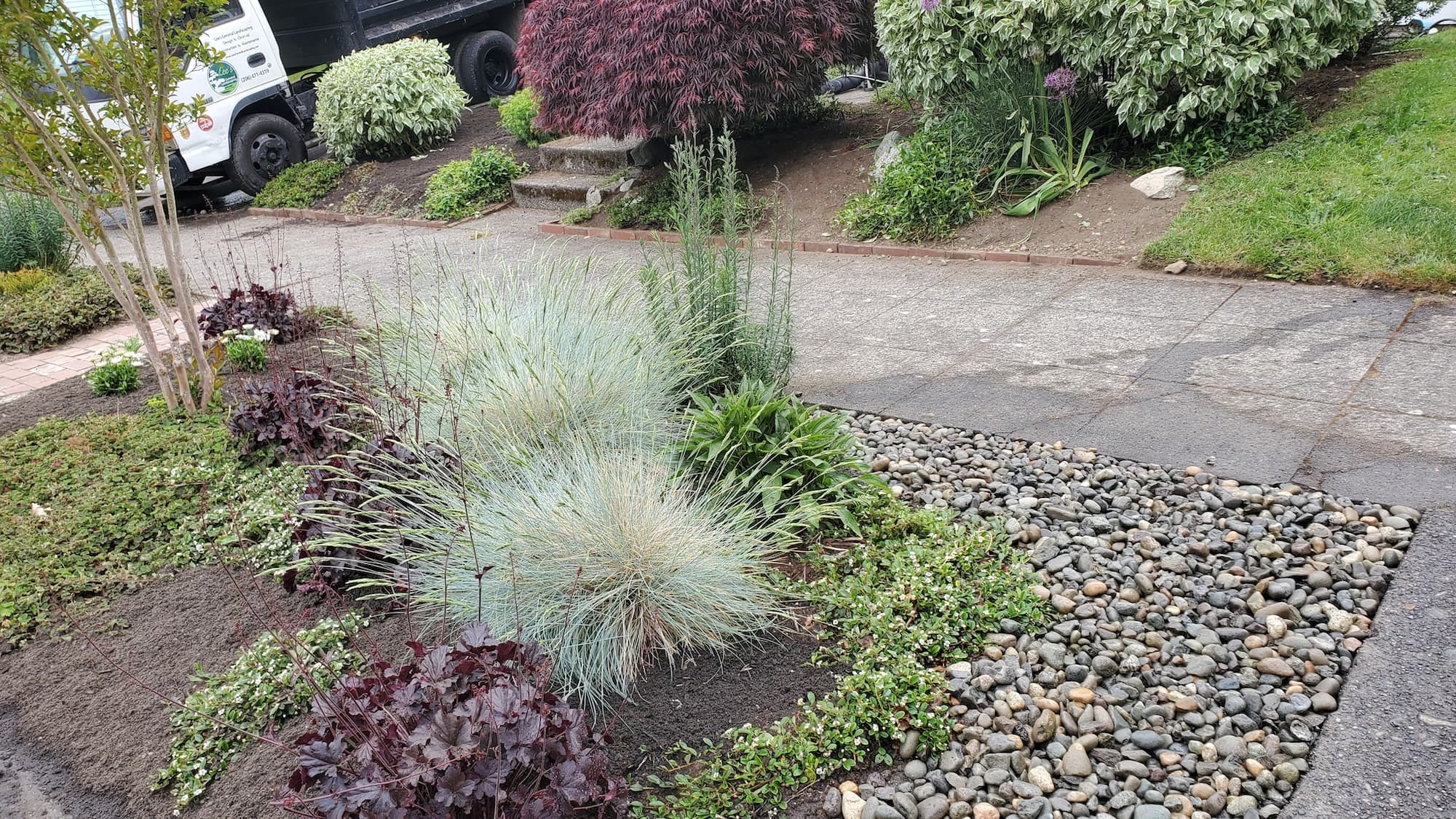West Seattle Rain Garden Installation Services
A bowl of mulch is not a rain garden. If you want stormwater to soak instead of flood paths and basements, you need right sizing, the right soil, and a legal overflow. We design and build rain gardens that take the hit in winter and still look good in August.
We serve Admiral, Alaska Junction, Alki, Fauntleroy, Arbor Heights, Delridge, Gatewood, High Point, Morgan Junction, and Roxhill.
What’s the Problem?
- Downspouts dumping at foundations; puddles and musty crawlspaces
- Side yards that turn into creeks every storm
- Mulch beds washing out; silt on sidewalks and stairs
- “Rain garden” that holds water for days (wrong soil, no overflow)
What We Build (function first, pretty second)
- Sized right — surface area typically 5–10% of the roof/patio area feeding it, tuned to your soil’s infiltration rate
- Bioretention soil mix — sandy, free-draining blend (no topsoil soup); 2–3” arbor mulch on top (no fabric in basins)
- Inlets that don’t crater — downspout tie-in to a rock splash pad or pipe boot with clean, angular drain rock
- Overflow that behaves — armored spillway to lawn, dry well, or dispersion trench (code-appropriate)
- Underdrain (when soil is slow) — perforated pipe in gravel with cleanout and solid-pipe outlet
- Bank planting — native and PNW-hardy shrubs/perennials that handle wet→dry cycles
- Edges you can maintain — neat transitions to lawn, paths, or beds; no mystery slopes
Straight talk: if your soil infiltrates < ½” per hour, we plan an underdrain or change tactics. No wishful thinking.
Our Method (no shortcuts)
- Site read & elevations — we shoot grades, map water paths, pick legal discharge points, and keep the basin 10’+ from foundations.
- Infiltration test — quick percolation check to decide if you’re infiltrate-only or infiltrate + underdrain.
- Layout & utilities — we call 811; we stay clear of major roots and critical areas unless properly permitted.
- Excavate the bowl — flat bottom, gentle side slopes; set check dam/berm with a rock-lined spillway.
- Soil build — place bioretention mix, then mulch (no landscape fabric in the basin, ever).
- Piping — downspout conveyance on solid pipe; perforated pipe only inside the basin/underdrain; cleanouts where you can reach them.
- Planting — grouped blocks (not polka dots) for fast canopy and weed suppression.
- Proof test — hose test the inlet/overflow and photo-document before we wrap.
Plant Palette That Thrives Here
Basins / wetter feet: slough sedge (Carex obnupta), Pacific ninebark (Physocarpus capitatus), Douglas spirea (Spiraea douglasii), red-twig dogwood (Cornus sericea), Oregon iris (Iris tenax), rush (Juncus spp.).
Banks / side slopes: evergreen huckleberry (Vaccinium ovatum), salal (Gaultheria shallon), sword fern (Polystichum munitum), kinnikinnick (Arctostaphylos uva-ursi), vine maple (Acer circinatum).
Pollinator color: Douglas aster (Symphyotrichum subspicatum), native yarrow (Achillea millefolium), camas (Camassia quamash).
Want lower watering? We size, then plant dense, then mulch. That’s the recipe.
Sizing & Ordering (so the math pencils)
Rule of thumb: Rain garden surface area ≈ 5–10% of contributing impervious area with decent soils.
Quick volume check:
- 1” rain on 1,000 sq ft of roof = ~623 gallons = ~83 cu ft (≈ 3.1 yd³).
- A basin with 6” ponding depth and 40% voids in soil/rock handles that if it’s sized correctly.
Bioretention mix: plan ~1–1.5 yd³ per 100 sq ft of basin (depth-dependent).
Rock: splash pads & underdrains usually need ¾”–1¼” clean; order 10–15% extra for lock-in.
Best Timing for West Seattle
- Fall to early spring installs root in with rain; we avoid major storm weeks for excavation.
- Summer is fine, but you’ll need more aftercare watering the first season.
Our Annual Maintenance Plan
- Inlet/overflow checks — clear leaves and grit before the first big fall storm
- Mulch & weed control — hold 2–3” depth; yank invaders before they seed
- Plant establishment — deep water in summer of Year 1; taper as roots dive
- Sediment scoops — remove silt at splash pads so infiltration stays high
We’re a low-maintenance landscaping crew. Our goal is fewer problems between visits and less work for you.
Service Cadences
- Quarterly — fall storm prep + winter/spring checks + summer tidy
- Bi-Monthly — great for heavy tree litter or steeper contributing areas
(New installs often start monthly for 60–90 days, then taper.)
What Annual Maintenance Includes
- Leaf/seed cleanup at inlets and spillways
- Mulch top-up and edge touch-ups for clean lines
- Plant health check and fill-in recommendations
- Underdrain/cleanout inspection and quick flush if needed
- Photo log so you can see performance (and bloom)
Why Annual Maintenance Matters
- Keeps water soaking — open inlets and fresh mulch maintain infiltration
- Protects structures — less splash/backflow toward foundations
- Looks better, longer — dense cover = fewer weeds and fewer bare patches
- Saves money — tiny tune-ups beat re-digs and re-plants
How It Works
- Free Estimate — photos/video or quick walkthrough; clear, upfront pricing
- Design — sizing, soil spec, and plant list matched to your site & code
- Build Day(s) — excavation, piping, soil, rock, planting, proof test, clean finish
- Follow-Up — simple care tips and a maintenance schedule that fits
Why West Seattle Chooses Neat & Tidy
- Local crew that knows clay pockets, winter rain, and tight alleys
- Licensed & insured; we call 811 and follow local discharge rules
- Upfront pricing — materials, labor, hauling, and disposal included
- On-time, respectful, clean work
- Green-first approach — native plants, infiltration-first design, landfill kept low
Ready to turn runoff into a landscape feature?
Call or text Neat & Tidy for a rain garden that’s sized right, drains right, and looks right—through West Seattle winters and summers. We’ll keep it tidy—so you don’t have to.










